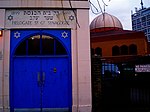Whitechapel Bell Foundry

The Whitechapel Bell Foundry was a business in the London Borough of Tower Hamlets. At the time of the closure of its Whitechapel premises, it was the oldest manufacturing company in Great Britain. The bell foundry primarily made church bells and their fittings and accessories, although it also provided single tolling bells, carillon bells and handbells. The foundry was notable for being the original manufacturer of the Liberty Bell, a famous symbol of American independence, and for re-casting Big Ben, which rings from the north clock tower (the Elizabeth Tower) at the Houses of Parliament in London. The Whitechapel premises are a Grade II* listed building. The foundry closed on 12 June 2017, after nearly 450 years of bell-making and 250 years at its Whitechapel site, with the final bell cast given to the Museum of London along with other artefacts used in the manufacturing process, and the building has been sold.Following the sale of the Whitechapel Bell Foundry, the bell patents were sold to the bell-hanging company Whites of Appleton in Oxfordshire, with which the foundry had a business relationship for 197 years. The rights to tower bell production are now under the ownership of Westley Group Ltd. Production of presentation and hand bells continues under the name Bells of Whitechapel Ltd.
Excerpt from the Wikipedia article Whitechapel Bell Foundry (License: CC BY-SA 3.0, Authors, Images).Whitechapel Bell Foundry
Whitechapel Road, London Whitechapel
Geographical coordinates (GPS) Address External links Nearby Places Show on map
Geographical coordinates (GPS)
| Latitude | Longitude |
|---|---|
| N 51.516944444444 ° | E -0.067222222222222 ° |
Address
Whitechapel Bell Foundry
Whitechapel Road 32-34
E1 1DQ London, Whitechapel
England, United Kingdom
Open on Google Maps









